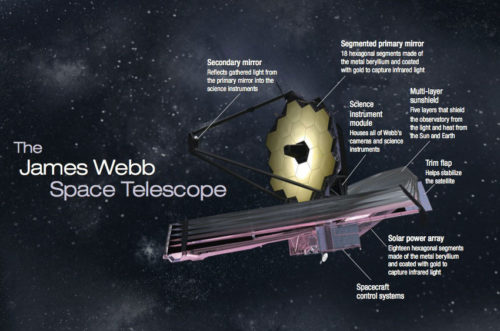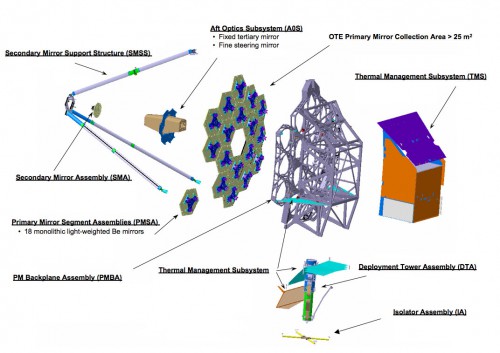
The James Webb Space Telescope, a joint project of NASA, the European Space Agency (ESA), and the Canadian Space Agency, is planned to be launched in 2018 on an ESA Ariane 5 rocket. The Northrop Grumman Corporation and its partner ATK have announced that the final component of the Primary Mirror Backplane Assembly (PMBA), called the backplane support frame, is now complete. The PMBA is the backbone that will support the telescope’s 6.5-meter segmented primary mirror and ensure the exact alignment of each of the gold-coated beryllium mirror segments.
Northrop Grumman is responsible for the design and development of Webb’s sunshield, telescope, and spacecraft. ATK is now adding the backplane support frame to the backplane center section, which it completed in April 2012, and the two backplane wing assemblies, which it completed in March. ATK has manufactured the thousands of composite parts of the PMBA using lightweight graphite components, connected with precision metallic fittings made of invar and titanium.

The PMBA center section will support 12 of the 18 primary mirror segments, while the two wings to be attached to each side of the center section will support three mirror segments each. This arrangement will allow the primary mirror to be folded up within the nose cone of the Ariane 5 launch vehicle and be fully deployed later, when the spacecraft is well beyond the Earth’s atmosphere. The newly built component, the backplane support frame, will connect the PMBA center section and the wings, as well as eventually support the aft optics subsystem of the telescope.
The full PMBA structure will be approximately 8 meters tall, 7 meters wide, and 4 meters deep. It will have a mass of 970 kilograms, but will support a mass over three times its own, in the form of the mirror segments and key optical subsystems of the telescope.
Being the backbone of a multi-billion dollar space telescope that will not only surpass the optical resolving power of the Hubble Space Telescope, but also the infrared resolving power of the Spitzer Space Telescope, the PMBA is expected to provide unprecedented thermal stability. This is vital, as the assembly must ensure the Webb Telescope’s optics are precisely aligned for its deep space operational environment of less than 40 Kelvin and also maintain that alignment through the physical stresses of launch and the subsequent cooling of the telescope from Earth ambient temperatures (of around 300 Kelvin).
Should the mirror fail to be precisely aligned when it reaches its mission destination near the Sun-Earth Lagrange point 2—a distance of 1.5 million kilometers from Earth—it would not be feasible to undertake a manned repair mission, as was the case with the Hubble Space Telescope.
Next steps in construction are to deliver the PMBA components to Marshall Space Flight Center later this year for extreme cryogenic testing and then return them to Northrop Grumman’s facilities for static structural testing before all components (the center, the wings, and the support frame) are fully integrated and ready to support the remaining components of the Webb Telescope.
The James Webb Space Telescope site contains more details about the construction of the telescope, including short Behind the Webb video clips about the construction of the PMBA center section and the two PMBA wings.
Be sure to “Like” AmericaSpace on Facebook and follow us on Twitter: @AmericaSpace
.
Missions » James Webb Telescope »



Too bad the damn thing only captures infrared imagery… Don’t expect the amazing pictures like from Hubble!
So it then only for capturing UFOs….
Hubble’s pretty pictures have all been narrowband (“hubble palette”) constructions using false-color filters. There is no difference between using bands located in the visual range for these, and using various bands located in the NIR and MIR. Hubble’s pictures in natural color for the most part look faintly deep red and are vastly overwhelmed by the brightness of stars. Sorry to burst your bubble.
I believe the article states that the JWST “will not only surpass the optical resolving power of the Hubble Space Telescope, but also the infrared resolving power of the Spitzer Space Telescope.” This amazing piece of NASA engineering genius will allow us to see far more than was ever possible, almost back to the dawn of time.
There’s some misunderstanding about comparing James Webb with Hubble. Every different space telescope launched, is primarily focused towards different wavelengths of light. Not one space observatory is identical to another. This is done so that the science from one space telescope complements the others and a full set of observations across much of the electromagnetic spectrum is conducted.
For instance, NASA’s Great Observatories, were:
a) Compton GRO, focused on gamma rays
b) Chandra, focused on soft X-rays
c) Spitzer, focused on infrared
d) Hubble, focused on near ultraviolet, visible, and later, near infrared.
From the JWST site (http://www.jwst.nasa.gov):
“Webb will observe primarily in the infrared and will have four science instruments to capture images and spectra of astronomical objects. These instruments will provide wavelength coverage from 0.6 to 28 micrometers (or “microns”; 1 micron is 1.0 x 10-6 meters). The infrared part of the electromagnetic spectrum goes from about 0.75 microns to a few hundred microns. This means that Webb’s instruments will work primarily in the infrared range of the electromagnetic spectrum, with some capability in the visible range (in particular in the red and up to the yellow part of the visible spectrum).
The instruments on Hubble can observe a small portion of the infrared spectrum from 0.8 to 2.5 microns, but its primary capabilities are in the ultra-violet and visible parts of the spectrum from 0.1 to 0.8 microns.
Hubble is 13.2 meters (43.5 ft.) long and its maximum diameter is 4.2 meters (14 ft.) It is about the size of a large tractor-trailer truck.
By contrast, Webb’s sunshield is about 22 meters by 12 meters (69.5 ft x 46.5 ft). It’s almost as big as a Boeing 737 airplane!
Webb will have a 6.5 meter diameter primary mirror, which would give it a significant larger collecting area than the mirrors available on the current generation of space telescopes. Hubble’s mirror is a much smaller 2.4 meters in diameter and its corresponding collecting area is 4.5 m2, giving Webb around 7 times more collecting area! Webb will have significantly larger field of view than the NICMOS camera on Hubble (covering more than ~15 times the area) and significantly better spatial resolution than is available with the infrared Spitzer Space Telescope.”
So, even though the James Webb will have some visible light coverage, it is not to be compared with Hubble. They’re both different telescopes for different purposes. And the science it will do, will help re-write astronomy and cosmology textbooks, as much as Hubble did throughout its history.
As is so often the case, your post is exemplary Leonidas. You would indeed be an invaluable asset to our great nation should you ever decide to immigrate. I would seek employment for you here in Detroit , but you would probably be safer enlisting in the American Army and volunteering for duty in Afghanistan. Thank you for the information on the JWST, I’m really looking forward to what it reveals, regardless of the part of the electromagnetic spectrum. We’ve still got to work on getting the pro-NASA AmericaSpace folks together for the first Orion/SLS launch!
Thanks Karol! It’s good to know that there are people as yourself out there, who value the important things 🙂 Actually, I felt inclined to post the info for the James Webb, because nowadays, so many people are finding fault with everything that NASA does, no matter the case, regardless if they understand it or not (it seems cool to be a NASA basher these days) and I wanted to set some records straight about the topic at hand. Anyway…
And yeah, an AmericaSpace gathering for the first SLS launch would be a blast, wouldn’t it?
As for immigrating, as is the situation here, it’s on the table. To tell you the truth though, I wouldn’t be considering the army-I had bad enough experiences with my time in the army here, to last me a lifetime.
Best regards Karol! 🙂
I hope everything goes well with JWST, despite its expense. When people argue that it should be cancelled because of cost, I think back to Neil deGrasse Tyson’s great perspective:
“Yes, cost overruns are bad, but, if there’s a cost overrun on anything in this world, should we be surprised when it comes about with something we’ve never done before? This is a telescope without precedent — in its size, in its power and scale, on how deep into the universe it’s going to reach, telling us about the origins of the cosmos. The engineering innovations that need to be brought to bare to make that happen are equally unprecedented.”
Hubble’s own cost overruns were significant as well, and in fact it did come very close to cancellation itself. Yet it’s hard to argue that the magnitude of its contributions to science and (almost more importantly) its inspirational power over the last 20 years have been well worth the money.
So well said Matt! That’e exactly the point and Neil deGrasse nails it.
So many people are focused on the little things, counting beans and stuff, and so few on the big things…
Agree with all that’s said here. That JWST is ‘NASA’s next-generation successor to the Hubble Space Telescope’ is NASA wording. The issue is not so much light wavelength as that Hubble is likely to become non-operational before the 2018 JWST launch. The HST gyroscopes will inevitably fail even if something else doesn’t break before then.
You’re absolutely correct Steve! My post was intended for those folks that seem to find fault with everything that NASA does. ‘Oh, the James Webb, is pork-infested, oh, it will not operate on the visible spectrum like Hubble, oh, it costs too much’ and stuff like that. So I just had to get it off my chest!
Best regards!
The JWST will bring new discoveries and wonders not only to the scientific community but to all human beings as well. Neil deGrasse Tyson’s perspective is spot on as well as those comments written by Karol, Leonidas, Matt and Steve. We, as a species, simply cannot afford NOT to continue such significant exploration of the cosmos. We must leave a lasting legacy for future generations, much in the same way as Apollo did over 40 years ago!